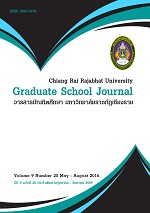图式理论在泰国彭帕塔纳威塔亚功中学汉语口语教学中的实验应用研究
Main Article Content
Abstract
一、看图说话教学辅助工具的重要组成部分是图画,其内容可具体可抽 象。多幅图画,图与图之间联系密切,有利于帮助学生开口说话,以及语言 组织能力的提升。笔者将《看图说话法》,《图式理论与口语输出》和《体 验汉语》第一、二册的课本的内容作为设计材料来源。设计4份看图说话教学 辅助教材:我的家庭、我们的周末、我要买新衣服和我们的学校。对学生进 行看图说话教学模式。教学过程共8课时,每课时50分钟,每周2课时。
二、看图说话教学辅助工具具有一定的可靠性,通过前后数据比较,我 们可以看出E1/E2分别为80.22/86.96。
三、通过学生前后测试成绩的平均数据高于43.41,标准差于21.20,百 分比对比结果显示,学生在看图说话教学模式后,成对样本检验的显著性为 .002,基本掌握口语交际训练,学生的汉语学习兴趣有所增加。学生的观察、 思考和表达能力也有所增强,汉语口语能力有所提高。
四、通过对看图说话教学法满意度问卷调查数据显示,大多数学生 对“看图说话教学模式”感到满意,总体平均数为4.42。
The Application of the Schema Theory in Teaching Chinese for Communication by Telling a Story from Pictures at Pongpattanawittayakhom School
The objectives of this research were as follows : 1) to study fundamental data for developing Matthayomsuksa 5 students’ Chinese speaking exercises by using pictures to tell stories, 2) to develop Matthayomsuksa 5 students’ Chinese speaking exercises using pictures to tell stories according to the efficiency standard of 80/80, 3) to compare Matthayomsuksa 5 students’ learning achievements before and after studying Chinese speaking exercises using pictures to tell stories, and 4) to survey study Matthayomsuksa 5 students’ opinion on Chinese speaking exercises using pictures to tell stories. The subjects for the research selected by simple sampling comprised 30 Matyhayomsuksa 5 students at Pongpatthana witthayakhom School in Pong District of Phayao Province in the 2nd semester of the academic year 2557. The research model was One Group Pretest-Posttest Design. The research tools were Chinese speaking exercises using picture, lesson plans, and questionnaires to survey study Matthayomsuksa 5 students’ opinion on Chinese speaking exercises using pictures to tell stories. The data were statistically analyzed by mean (x) standard deviation (S.D) and dependent t-test.
The findings were as follows :
1. Chinese speaking exercises using pictures to tell stories must contain pictures which could be described and varied. Each picture should co-relate to one another to enable students to tell stories and also to expose more skills in composing sentences. The researcher applied the approach of story telling from pictures according to the Schema Theory with Experiencing Chinese Book 1 and Book 2 then designed 4 sets of Chinese speaking exercises by using pictures to tell stories : My Family, Our Weekends, I Want to Buy New Clothes, and Our School. The duration of the experiment totally lasted 8 periods (50 mins./period).
2. Chinese speaking exercises using pictures to tell stories had 80.22/86.96 according to the efficiency standard of 80/80.
3. The students’ learning achievements before and after studying Chinese speaking exercises using pictures to tell stories were significantly different at the level of .01 meaning that the students’ learning achievements after studying Chinese speaking exercises using pictures to tell stories were higher. The students thought that such activities were interesting and enabled them to expose more skills in thinking and speaking.
4. The students were satisfied with Chinese speaking exercises using pictures to tell stories at the high level.
Article Details
บทความที่ได้รับการตีพิมพ์เป็นลิขสิทธิ์ของวารสารมหาวิทยาลัยราชภัฎเชียงราย
ข้อความที่ปรากฏในบทความแต่ละเรื่องในวารสารวิชาการเล่มนี้เป็นความคิดเห็นส่วนตัวของผู้เขียนแต่ละท่านไม่เกี่ยวข้องกับมหาวิทยาลัยราชภัฎเชียงราย และคณาจารย์ท่านอื่นๆในมหาวิทยาลัยฯ แต่อย่างใด ความรับผิดชอบองค์ประกอบทั้งหมดของบทความแต่ละเรื่องเป็นของผู้เขียนแต่ละท่าน หากมีความผิดพลาดใดๆ ผู้เขียนแต่ละท่านจะรับผิดชอบบทความของตนเองแต่ผู้เดียว

